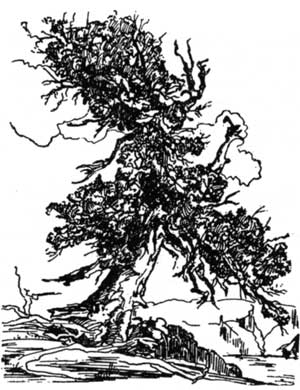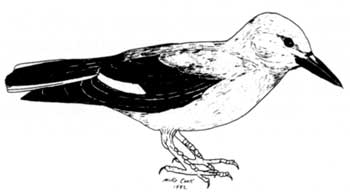|
Volume XXIV - 1993

Where Have the Whitebark Pines Gone?
By Steve Mark and Ron Mastrogiuseppe
Even a cursory glance at the landscape reveals that vegetation is
not distributed at random, but occurs in mosaics as an expression of
several interacting variables. The whitebark pine (Pinus
albicaulis, meaning white-stemmed pine) is a tree found at Crater
Lake National Park generally above 6500 feet on exposed slopes in dry,
rocky soils. This tree is easily identified by its whitish-gray bark and
often twisted branches. Although Crater Lake National Park has no true
timberline, whitebark pine forms the elfinwood or krummholz of
timberline in many western mountain ranges.
Whitebark pine is a pioneer species colonizing subalpine habitats as
the first tree. An amazing example of its pioneering ability can be seen
at the Newberry caldera where whitebark pine is the only tree
established upon the relatively recent obsidian surface; even the nearby
lodgepole pines (P. contorta, subsp. murrayana) abruptly end near
the toe of the flow. At the Crater Lake caldera, whitebark pine may have
been the first tree to colonize the pumice slopes of old Mount Mazama
within the first century following the climactic eruption. Whitebark
pine is generally encountered as a pioneer tree, as there are several
places around the caldera rim where old mothertrees provided a favorable
microclimate for the establishment beneath their canopy of subalpine fir
(Abies lasiocarpa) or mountain hemlock (Tsuga
mertensiana). Whitebark pine is arranged in ribbons or bands along
the contours of Cloudcap and other habitats along the caldera's edge.
These sites represent slightly higher, rocky substrate for the survival
of whitebark seedlings since exposed areas devoid of snow earlier in the
year have a significantly longer growing season.
Most pine seeds have wings for wind dispersal, but whitebark seeds
have retained only a rudimentary wing. The dispersal agent has become
the Clark's Nutcracker (Nucifraga columbiana). These birds have
learned to retrieve whitebark seeds with their specialized beaks,
storinga number in their sublingual pouch, and methodically storing
seeds in soil caches. Only a fraction of the seed caches are retrieved,
however, so some caches sprout seedlings in clumps which may grow into
larger whitebark pine colonies.
Whitebark pine appears to be sensitive to a certain set of
environmental conditions. Although it is often viewed only as an
indicator of a short "rowing season and cold temperatures, this species
occupies a niche in the subalpine forest that is far from simple. The
tree can be found in relatively pure stands or in association with
lodgepole pine and western white pine (P. monticola). The
distribution of related species like limber pine (P.flexilis),
bristlecone pine (P. longaeva), and foxtail pine (P.
balfouriana) somewhat overlap that of the whitebark and can occupy
what would often seem to be the latter's place forming the edge of
timberline. Whitebark pine's distribution poses some nagging questions
to dendrologists. For example, it provides the name for Nevada's Pine
Forest Range but mysteriously remains absent in similar subalpine
habitats on Steens Mountain in southeastern Oregon, only several air
miles to the north. In southern Oregon, the whitebark pine may have
disappeared on Mount Ashland in recent times and is presently almost
gone from the top of Crater Lake's Wizard Island.
One of the reasons that whitebark and other pines are often so
puzzling is that species of Pinus display much variation as well as many
similarities. For example, whitebark pine and limber pine (the rarest
native coniferous species in Oregon, but more common in the Great Basin
and northern Rockies) mimic each other in many characters. Similarly,
the ponderosa pine (P.) found along Annie and Sun creeks, for
instance, display a strong Washoe pine (P. washoensis) element.
This is thought to be a high elevation variant of the ponderosa's
northwestern distribution and may account for its presence at higher
elevations inside the caldera. Genetic variability in the park's
whitebark pine may not be as great as in the ponderosa forests, but the
loss of a population as small as the one on Wizard Island may imperil a
distinct local seed source.
What is disturbing about the whitebark pine of Wizard Island is
their seemingly rapid decline. Photographs taken at various times
through the 1960s show living trees on top of the island. By July 1991,
however, the authors could find only one living specimen. This small
population's relatively sudden nosedive may be due to one or several
causes. Might it be human activity, air pollution, drought, mountain
pine beetle, or blister rust infection? The whitebark's decline is more
likely tied to a combination of these factors, which makes the testing
of single hypotheses (a key to the application of scientific method to
the problem) very difficult or, at best, inconclusive.
Efforts aimed at monitoring environmental change in national parks
like Crater Lake are generally handicapped by the lack of critical
baseline information. Material available to the historian may help to
reconstruct past conditions, but investigators should be aware of their
possible shortcomings. The documentary record is limited to the historic
period, whether it is in the form of photographs or writings.v
Repeat photography is constrained by the scale and resolution of the
original photo, as well as by the identifiable background features that
allow a view to be replicated. Observations about the condition of
flora throughout the park are usually fragmentary. Some describe what
would seem to be unlikely events, even though the journalist may
otherwise be credible. One example is a newspaper article of 1903 where
Klamath Falls hotelier and photographer Maud Baldwin noted that Wizard
Island was '"alive with grasshoppers. " Sufficient detail or locality
data to verify an observation can be a problem, too. Much effort was
expended by Crater Lake's chief park naturalist in the 1960s trying to
track clown a colleague's discovery of the prostrate juniper
(Juniperus communis) specimen probably living near the Watchman
in 1929.
Other changes that might have occurred during the historic period
lack any form of documentation. Just one of many examples in the park is
the poor condition of Sun Meadow's vegetation when compared to the
floral mosaic of Sun Notch. Simplistic explanations, such as sheep
grazing prior to the park's establishment or a poor soil nutrient
budget, are often offered by park staff when the limitations of
available evidence or funding seem to frustrate efforts to study the
situation further.
What the whitebark's disappearance on Wizard Island may illustrate,
as have the attempts to understand fluctuations in Crater Lake's
clarity, is that we really under stand very little about the park's
ecosystems. Certainly more research is essential, but the limitations of
available data have to be accepted since causation may be due to a
number of factors not easily separable into testable hypotheses. Instead
of certainty, all history and science can yield is a prediction of
possibilities if the limitations affecting available evidence can be
overcome through sound methodology.
Explanations based on models of complexity rather than simplicity
will have to be complemented, however, by a willingness to admit that
sometimes we do not have all the answers. Since whitebark pine ring the
summit crater which provides the lake's name, what better symbol of
uncertainty could there be for a phenomenon as complex as Crater
Lake?

| 
